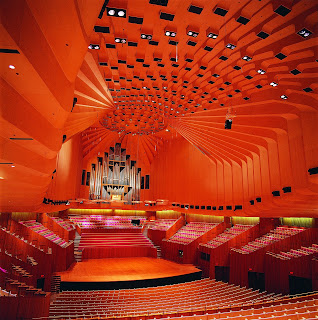 Sydney Opera House
Sydney Opera House
The Sydney Opera House is a multi-venue performing
arts centre in Sydney, Australia, identified as one of the 20th century's most
distinctive buildings.
Designed by Danish architect Jorn Utzon, the building
was formally opened by Elizabeth II, Queen of Australia, on 20 October 1973. A
large crowd attended. Utzon was not invited to the ceremony, nor was his name
mentioned. The opening was televised and included fireworks and a performance
of Beethoven's Symphony No. 9. On 20 October 1973 after a gestation beginning
with Utzon's 1957 selection as winner of an international design competition.
The government of New South Wales, led by the premier, Joseph Cahill,
authorised work to begin in 1958 with Utzon directing construction. The government's
decision to build Utzon's design is often overshadowed by circumstances that
followed, including cost and scheduling overruns as well as the architect's
ultimate resignation.
The Sydney Opera House became a UNESCO World Heritage
Site on 28 June 2007.
The building and its surrounds occupy the whole of
Bennelong Point in Sydney Harbour, between Sydney Cove and Farm Cove, adjacent
to the Sydney central business district and the Royal Botanic Gardens, and
close by the Sydney Harbour Bridge.
Though its name suggests a single venue, the building
comprises multiple performance venues which together are among the busiest of
performing arts centres - hosting well over 1,500 performances annually,
attended by more than 1.2 million people. A wide range of performances is
presented in the venues, by numerous performing arts producers, including four
key resident companies: Opera Australia, The Australian Ballet, the Sydney
Theatre Company and the Sydney Symphony Orchestra. As one of the most popular
visitor attractions in Australia, more than eight million people visit the site
each year, with around 350,000 visitors annually taking a guided tour of the
building.
The building is managed by the Sydney Opera House
Trust, an agency of the New South Wales State Government.
The facility features a modern expressionist design,
with a series of large precast concrete "shells", each composed of
sections of a sphere of 75.2 metres (246 ft 8.6 in) radius,forming the roofs of
the structure, set on a monumental podium. The building covers 1.8 hectares
(4.4 acres) of land and is 183 m (600 ft) long and 120 m (394 ft) wide at its
widest point. It is supported on 588 concrete piers sunk as much as 25 m (82
ft) below sea level.
Although the roof structures are commonly referred to
as "shells" (as in this article), they are precast concrete panels
supported by precast concrete ribs, not shells in a strictly structural sense.Though
the shells appear uniformly white from a distance, they actually feature a
subtle chevron pattern composed of 1,056,006 tiles in two colours: glossy white
and matte cream. The tiles were manufactured by the Swedish company Höganäs AB
which generally produced stoneware tiles for the paper-mill industry.
Apart from the tile of the shells and the glass
curtain walls of the foyer spaces, the building's exterior is largely clad with
aggregate panels composed of pink granite quarried at Tarana. Significant
interior surface treatments also include off-form concrete, Australian white
birch plywood supplied from Wauchope in northern New South Wale
Of the two larger spaces, the Concert Hall is in the
western group of shells, the Joan Sutherland Theatre in the eastern group. The
scale of the shells was chosen to reflect the internal height requirements,
with low entrance spaces, rising over the seating areas up to the high stage
towers. The smaller venues (the Drama Theatre, the Playhouse and the Studio)
are within the podium, beneath the Concert Hall. A smaller group of shells set
to the western side of the Monumental Steps houses the Bennelong Restaurant.
The podium is surrounded by substantial open public spaces, and the large
stone-paved forecourt area with the adjacent monumental steps is regularly used
as a performance space.
Performance venues and facilities
The Sydney Opera House includes a number of
performance venues:
Concert Hall: With 2,679 seats, the home of the Sydney
Symphony Orchestra and used by a large number of other concert presenters. It
contains the Sydney Opera House Grand Organ, the largest mechanical tracker
action organ in the world, with over 10,000 pipes.
Joan Sutherland Theatre: A proscenium theatre with
1,507 seats, the Sydney home of Opera Australia and The Australian Ballet.
Until 16 October 2012 it was known as the Opera Theatre.
Drama Theatre: A proscenium theatre with 544 seats,
used by the Sydney Theatre Company and other dance and theatrical presenters.
Playhouse: An end-stage theatre with 398 seats.
Studio: A flexible space with a maximum capacity of
400, depending on configuration.
Utzon Room: A small multi-purpose venue, seating up to
210.
Recording Studio
Outdoor Forecourt: A flexible open-air venue with a
wide range of configuration options, including the possibility of utilising the
Monumental Steps as audience seating, used for a range of community events and
major outdoor performances.
Other areas (for example the northern and western
foyers) are also used for performances on an occasional basis. Venues are also
used for conferences, ceremonies and social functions
The building also houses a recording studio, cafes,
restaurants, bars and retail outlets. Guided tours are available, including a
frequent tour of the front-of-house spaces, and a daily backstage tour that
takes visitors backstage to see areas normally reserved for performers and crew
members.
 |
| opera house at night |
 |
| opera house's front view |
source: https://en.wikipedia.org/wiki/Sydney_Opera_House


Komentar
Posting Komentar